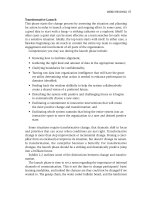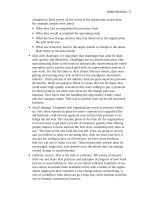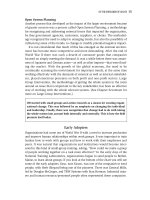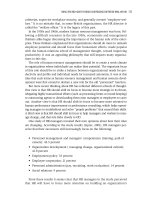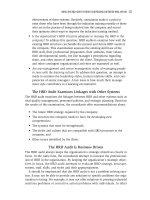Practicing Organization Development (A guide for Consultants) - Part 38 pdf
Bạn đang xem bản rút gọn của tài liệu. Xem và tải ngay bản đầy đủ của tài liệu tại đây (212.52 KB, 10 trang )
EVALUATION 341
Checking
41. Every meeting is evaluated by the team. 5 4 3 2 1
42. Suggestions for improvement are made. 5 4 3 2 1
43. Team members provide positive 5 4 3 2 1
feedback to each other.
44. Team members provide constructive 5 4 3 2 1
feedback for improvement to each other.
Acting
45. Minutes are distributed to all 5 4 3 2 1
participants within two days.
46. Team members carry out their 5 4 3 2 1
assignments related to action steps.
47. Additional agenda items are provided 5 4 3 2 1
to the team leader in time to include
on the distributed agenda.
Overall
48. [Our leader] provides good 5 4 3 2 1
leadership to the team.
49. I look forward to our team meetings. 5 4 3 2 1
50. I am generally satisfied with our team 5 4 3 2 1
meetings.
Exhibit 12.4. Comparison of Advantages for Customized vs. Standardized Surveys
Customized Surveys Standardized Surveys
• Can be adapted to the vocabulary of the
organization
• Can be focused to the specific variables of
interest to a particular OD process
• Owned by the organization when developed
• Less costly over time
• Participants feel more ownership in the
survey and evaluation processes
• Because results cannot be compared with
other organizations, the focus is on
organizational improvement, not comparison
with how others are doing
• Readily available without developmental
time
• More likely to have appropriate psychometric
measures (reliability, validity)
• Unlikely to change over time, so comparison
can be made across time
• Likely to have been used in multiple
contexts, providing comparative data
(though this may not be what is wanted)
• Will often look more professional (though
this is not necessarily so)
• May already be available in web-based format
Practicing Organization Development, 2nd Ed Copyright © 2005 by John Wiley & Sons, Inc. Reproduced
by permission of Pfeiffer, an Imprint of Wiley. www.pfeiffer.com
18_962384 ch12.qxd 2/3/05 12:18 AM Page 341
Measurable Outcomes
As specified earlier in this chapter, there are a number of measures that are gen-
erally available in most organizations that could be used to determine the
impact of the OD process on these outcomes. For example, it would be relatively
easy to determine whether a predetermined sales level had been achieved,
whether there had been an improvement in the number of complaints filed,
whether attendance has improved, and on and on the list could go. All of these
are quantitative items that are relatively easy to measure. The major difficulty
in their use, of course, is determining the cause of the improvements. So many
things can cause changes in these measures—the weather, the external econ-
omy, an increase in the advertising budget, changes in personnel—in addition
to the OD process. It is almost impossible to determine that any specific change
was caused by the OD process.
Comparison with Competitors
Preferably, when benchmarking is done, it is a comparison of processes used.
In practice, companies often look at outcome measures, for example, produc-
tivity measures, quality measures, market share, return on investment, and so
on. These, too, are quantitative measures. Looking only at differences in num-
bers is not particularly useful, because the important information (how the out-
comes were obtained) is not known. These comparative measures are also not
always easy to obtain. When industry groups collect such information for
benchmarking purposes, membership in that industry group is usually all that is
needed to gain access to the information. When industry groups do not collect
desired measures, however, the information can be very difficult to acquire. Pub-
licly owned businesses may be required to have such information on file
because of Security Exchange Commission requirements. Privately owned busi-
nesses, however, may be very reluctant to share such information.
Cost/Benefit Analysis
Another quantitative approach to evaluation is a comparison of the costs of the
OD process compared with the perceived or anticipated benefits. This approach
requires a group of knowledgeable individuals within the client organization to
estimate the financial benefits from the process and compare these against the
costs, both explicit and implicit. If this return rate is greater than alternative
investments, then the investment in the OD process is (or was) worthwhile.
Psychometric Requirements
There are three basic principles of measurement: validity, reliability, and prac-
ticability. These provide credibility and meaning to information derived from
measurement. Unfortunately, because the first two are technical in nature, often
342 PRACTICING ORGANIZATION DEVELOPMENT, 2ND EDITION
18_962384 ch12.qxd 2/3/05 12:18 AM Page 342
client- or consultant-developed instruments do not pay attention to these
requirements. Unfortunately, this occurs occasionally with commercial instru-
ments as well. When using an instrument, questions about these principles
should be asked.
Validity ensures that the instrument measures what it is intended to measure.
Although there are many types of validity, the two most important for OD eval-
uation are face validity and predictive validity.
Face validity refers to the perceived accuracy and appropriateness of the
instrument with respect to the stated outcomes. Ultimately, such validity will
be determined by whether the organization’s indicated needs are met by the OD
process. The results should make sense to those knowledgeable about the orga-
nization and OD and should match the information sought by stakeholders or
decision makers.
Predictive validity is the ability of one measure to predict performance on
some other measure. It requires the collection of data during the intervention
to be correlated at a later date with results data gathered on the job. If there is
predictive validity, there should be a high correlation between formative mea-
sures and workplace measures.
Reliability means that the instrument would obtain the same results if used
several times. Reliability is associated with consistency and accuracy. It is eas-
ier to determine reliability than it is to determine validity. An instrument must
be reliable if it is to be valid.
A nonnumeric approach that will improve reliability—but not show whether
the instrument is, in fact, reliable—is to complete a pilot study with a small
sample of employees prior to full-scale administration of the instrument. The
OD consultant should check responses to identify where misunderstandings
might exist, ask those completing the instrument where they encountered dif-
ficulties, and then revise the instrument based on the responses.
A test-retest procedure consists of administering the instrument to a pilot
group and then administering it again to the same group after a brief interlude
(perhaps a week). The correlation of the two sets provides a measure of stabil-
ity. Another approach is to determine subscores for odd-numbered questions
and even-numbered questions for each respondent and obtain a correlation
between the two sets of scores. The closer the correlation is to 1, the higher the
reliability. Finally, Cronbach’s alpha and factor analysis are additional statisti-
cal measures that can be used for reliability determination. (For more informa-
tion on calculating reliability, see Fitz-Gibbon & Morris, 1987.)
Practicability means that the instrument can be completed within a reason-
able amount of time with tools that are readily available. Administering the
instrument to a pilot group is an excellent way to determine the clarity of items,
consistency of interpretation, time needed, and administrative detail needed.
EVALUATION 343
18_962384 ch12.qxd 2/3/05 12:18 AM Page 343
Qualitative
There are also a number of approaches to evaluation that do not result in
numeric data, yet the information can still be very useful. In fact, qualitative
data may provide the evaluator with more depth of understanding about the
processes and how they are being perceived. In addition, they can often be
implemented “on the fly,” providing immediate feedback.
Informal Group Processes. Many useful, informal evaluation processes can
yield intuitive or qualitative data. Among others, these can include:
• Polling members of a large group by having them raise their hands to
indicate their levels of satisfaction, showing five fingers for very satisfied
and only one finger for very dissatisfied.
• Doing a “whip” (having each member speak in turn) to obtain verbal
feedback ranging from testimonies to constructive criticism.
Interviews. An interview guide can be used to ensure that exactly the same
questions are asked in the same order with all interviewees. For a structured inter-
view, the guide would be quite detailed. An unstructured interview—although less
precise—allows the interviewer to follow new trains of thought. The guide for an
unstructured interview may contain just a few questions, such as the following:
• “What is going better for you in your job now, compared with the way it
was before the intervention?”
• “What is not going as well for you in your job now, compared with the
way it was before the intervention?”
• “If you could make just one change in what we are doing now, what
would it be?”
• “What else would you like to share with me?”
Focus Groups. A variant of an interview is a focus group. In essence, a focus
group is a group interview. The same questions as suggested for interviews can be
used for focus groups. A focus group is particularly useful when you want people
to build on others’ comments. The downside of a focus group is that it can con-
tribute to “groupthink,” the tendency for a dominant voice to influence others to
think in the same way, regardless of whether that really reflects how they think.
Observation. Observing changes that have taken place (or are taking place)
in the workplace can provide indications of progress, resistance, and learning.
There may be occasions when videotaping an event (for example, a team meet-
ing) can provide a useful tool for assisting in the observation process. Observing
in two areas of an organization, one of which has participated in the OD process
and the other which has not, can also be helpful.
344 PRACTICING ORGANIZATION DEVELOPMENT, 2ND EDITION
18_962384 ch12.qxd 2/3/05 12:18 AM Page 344
Anecdotes. Ask the steering committee of the OD process, the client, or
members of the client organization for subjective responses to key issues—on
a daily basis (at the micro level) or as a monthly/yearly review (at the macro
level). Stories are a common way for people to share what is really important
to them.
REPORTING THE OUTCOMES OF THE EVALUATION
Having data is not enough. Data and the corresponding results can be com-
pelling to the person conducting the evaluation and to no one else. The aim in
reporting results is accessibility. When the results from an evaluation are truly
accessible, people understand the data in a way that empowers each person to
take action. There are a variety of ways to report data:
• Charts and Graphs—pictorially presented data that give the viewer a
comparative appreciation for the numbers. Charts and graphs show
how the measures compare to each other and aggregated measures such
as the mean and standard deviation (an indication of the variation in
the data). Means and standard deviations can be reported from the
existing data or other relevant data from such stakeholder groups as
another department, competitors, industry, and society.
• Scorecards—a summarized or key set of measures that is important for
everyone to see and track over time. These measures are often able to be
seen on one page and address such things as satisfaction, productivity,
learning, and profit (for more detail, see Kaplan & Norton, 1996).
• Metaphors—a story or picture that captures the meaning of the data
and relationships among key variables. Data can be put into a story-
board that captures the key relationships in the form of a story that
integrates metaphor with charts and graphs. An example of this
approach as applied to major corporations can be found at Root
Learning (www.rootlearning.com).
• Predictive Models—a picture that shows the relationships among a vari-
ety of key measures that flow to important end-result outcomes. This
concept was popularized by Sears, which developed the concept of the
employee-customer-profit chain (Rucci, Kirn, & Quinn, 1998).
Each method above can support existing change initiatives and can lead to
change being initiated. As will be discussed next, the idea of creating a systems
view of the organization requires drawing from all the tools for reporting out-
comes described above. Creating a systems approach is the best way to truly
change behaviors.
EVALUATION 345
18_962384 ch12.qxd 2/3/05 12:18 AM Page 345
USING EVALUATION TO CHANGE
BEHAVIORS MOVING FORWARD
The most compelling way to change behaviors is to give an objective assess-
ment of the behavior and other related factors. That is, a systems approach is
the best approach to creating sustainable change in organizations. Developing
a predictive model in an organization is important in ensuring that the organi-
zation takes the necessary action. One principle of Gestalt theory is that, when
a system fully understands itself, it will know what to do next (Emery, 1978).
The act of noticing the self is the most powerful tool for change. We advocate
creating a systems model that puts the pieces together and paints a very descrip-
tive picture of the organization. This type of modeling provides diagnostic feed-
back at the individual, department, site, and organizational levels. The system
modeling process is grounded in theoretical development concepts and field
research methodology. These are important components in creating a whole sys-
tem predictive model for an organization. The steps are summarized below.
Step 1: Evaluate Existing Models and Measures
The goal in this step is to map the explicit and implicit relationships. Mapping
the perceived relationships is important for future steps. Most people have an
innate need to express and hypothesize. For example, someone may believe
that, as the organization’s employee job satisfaction increases, the turnover rate
will decrease. This is a hypothesis, because it is proposing a relationship
between two variables. Clarifying existing hypotheses gets people involved in
exploring additional relationships and other performance-related questions (for
more information, see Hedrick, Bickman, & Rog, 1993; Keppel, 1982). There are
five key questions to ask:
• What types of data are being collected?
• What are the location, retrieval mechanisms, and quantity of stored
data?
• How are the data being collected?
• Why are the data being collected?
• What are the expected relationships among the variables?
Detailing existing models and measures will, without a doubt, stir up cogni-
tive dissonance and resistance with key stakeholders. A rigorous examination
and use of information can be intimidating to organizational members, includ-
ing leaders (Harrison, 1994). This step will indicate the pace and method with
which you should proceed. In some cases it might be advisable not to proceed.
The leaders of the organizations or unit utilizing this process must embrace the
346 PRACTICING ORGANIZATION DEVELOPMENT, 2ND EDITION
18_962384 ch12.qxd 2/3/05 12:18 AM Page 346
reality that there will be positive and negative findings. This process is based
on the value of truth and objectivity. While the truth can set you free, develop-
ing and maintaining performance management systems requires more effort and
discipline than many existing managers practice. Going by intuition is quicker
and not easily verified. It also lends itself to political maneuvering. That is, a
disjointed performance management system with unreliable measures empow-
ers leaders to make quick decisions and move their agendas forward without
much justification. The decisions can be supported by anecdotal evidence that
may or may not be reliable.
Step 2: Enhance Existing Models and Measures
Based on the analyses conducted in the previous step, a new set of questions
should surface and a better idea of the whole performance system should begin
to emerge. The three prongs of sound thinking are instrumental in developing
a more thoughtful and testable model and can be easily framed as questions.
Prong one—what do you currently know about “X”? Most people will go on a
hunch by using easily accessible information. It may be effective, but it will not
be helpful in more complex decisions and modeling like the approach being pro-
posed here. Prong two—what do the experts, research findings, and theories
say about “X”? Some people will review expert research findings. This will get
at important research and relevant theoretical issues. However, it lacks the nec-
essary practical implications associated with benchmarking. And, prong three—
what are best and worst in class doing with regard to “X”? Benchmarking may
be a valuable tool, but it must be assessed with the unique knowledge that
exists in the organization (prong one) and expertise outside the organization
(prong two). The three prongs of sound thinking should be conducted com-
pletely and in the order described. The questions presented above can be posed
in a variety of forms and are presented as examples to get you started. The
results for people using an exercise like this are confidence in the decisions
made, better decisions, and an appreciation for sound thinking.
Step 3: Install and Initiate Data-Collection Process
The process by which data are gathered and stored can be overwhelming. The
focus of this step is on getting the most reliable, relevant, efficient, and accu-
rate data. It is important to consider where to house the organization’s data.
Many organizations keep their information decentralized. In some cases, infor-
mation is kept from other parts of the organization. Creating a whole system
model requires that all information be centralized. There are exceptions to this
prescription, but it should be explicitly addressed and agreed on. While data
warehousing is centralized, the collection process can be decentralized. Because
there are various ways to measure something, the previous steps should be used
to choose the best measurement protocol. As for the timing of data collection,
decisions have to be made about frequency, date, and time.
EVALUATION 347
18_962384 ch12.qxd 2/3/05 12:18 AM Page 347
Step 4: Diagram the Predictive Model
Diagramming the predictive model requires conducting statistical analyses and
visually mapping the significant and meaningful relationships. Examining rela-
tionships in the whole system model requires at least two questions to be
answered. First, what relationships are significant? As relationships are shown
to be significant or not significant, the model’s validity becomes apparent and
the opportunity for refinement becomes clearer. For those relationships that are
not significant, the variables in question may need to be revised or removed.
Second, how important and meaningful is the significant relationship? This is
determined by statistical tools that provide information as to the amount of vari-
ance explained by the predictors in the performance variables of interest. Mean-
ingfulness also refers to the degree of impact a predictor variable has. That is, as
the predictor variable moves (that is, up or down), what degree of change does
it create in the outcome variables? For example, a 3 percent increase in employ-
ees’ perceptions of environmental support may lead to a 2 percent increase in
critical customer service behaviors, thus leading to a 3 percent increase in cus-
tomer intention-to-return. This 3 percent increase in customer intention-to-return
may then lead to a 4 percent increase in actual customer retention and a 2 per-
cent increase in sales. This example indicates that a relatively small change in a
predictor variable can translate into a large leap in performance.
Step 5: Use the Feedback Process to Initiate Action
Feeding back the results from performance modeling can be productive and
challenging. The objective is to facilitate a healthy and constructive discussion
that leads to action. Figure 12.5 presents a simple model that can be used to
facilitate the discussion. It is based on clearly separating the facts of the situa-
tion from judgments and emotions.
To begin, identify the relevant facts. Facts are objective, measurable, and
observable information. Second, draw judgments (also called conclusions) from
agreed-on facts. Judgments are value-laden opinions (that is, good and bad)
related to the relative importance of the information. The modeling process pro-
vides facts related to causal relationships among the soft and hard measures.
These facts can be helpful in evaluating longstanding judgments that have
existed in the organization. With empirically based facts, the judgments are
more objective and the emotional ramifications can help to build consensus.
Therefore, it is important to clearly connect facts to judgments. Next, it is impor-
tant to share the emotions that are surfacing as the facts are shared and judg-
ments are formed (happy, sad, mad, fear, and guilt). Using the performance
model to facilitate the sharing of emotions can be helpful in eliminating the static
that often interferes with interpersonal communication. Finally, after coming to
consensus on judgments regarding the facts, ask the following question: “What
do you choose to do?” This is the step that promotes action and accountability.
348 PRACTICING ORGANIZATION DEVELOPMENT, 2ND EDITION
18_962384 ch12.qxd 2/3/05 12:18 AM Page 348
We recommend that the model in Figure 12.5 be presented at the beginning of
the feedback session as part of the ground rules. Use the model explicitly as a
tool for keeping discussion focused and constructive.
BARRIERS TO EVALUATION
It is difficult for any professional to seek input on the quality of his or her prod-
uct or service and the level of his or her expertise. For this reason, some con-
sultants and clients create barriers—real and imagined—to planned evaluation.
The following are some factors that discourage evaluation.
Lack of Money
The decision makers of a client organization may believe that the benefits of
an evaluation do not warrant the expenditure for the OD consultant to conduct
the evaluation. They may believe that the funds would be better spent on addi-
tional interventions. In our experience, this seems to be the major barrier to OD
evaluation.
Lack of Time
An OD consultant may find that commitments to other clients create time con-
flicts that will not allow him or her to conduct an effective evaluation. In the
EVALUATION 349
Figure 12.5. Components for Facilitating a Healthy Feedback Session
Facts
Emotions Judgments
18_962384 ch12.qxd 2/3/05 12:18 AM Page 349
same way, the decision makers of an organization may be impatient to move
on and not want to take the time to conduct an evaluation.
Organizational Politics
The contact person within the client organization may have taken a significant
risk in contracting with an external consultant or in championing the hiring of
an internal consultant. An evaluation may lead to the conclusion that the inter-
vention was not successful, thereby confirming the poor judgment of the con-
tact person in deciding to use an OD consultant or in selecting the particular
consultant.
Consultant Reputation
An OD consultant may be reluctant to conduct an evaluation. If the evaluation
is positive, it may be thought that the consultant influenced the assessment of
his or her own work. If the assessment is negative, the client organization—as
well as the consultant—may feel that a lack of expertise is indicated. This could
jeopardize the consultant’s role within the contract and the client organization
and could affect his or her reputation in the OD field.
Lack of Measurable Variables
Some interventions produce outcomes that are not easily measured. If this is
the case, the difficulty of the evaluation task may lead the client and the con-
sultant to avoid it.
Lack of Competence
Many OD consultants have more training and experience in conducting inter-
ventions than they do in conducting evaluations. Therefore, they may feel more
comfortable conducting interventions than they do conducting evaluations, so
they tend to emphasize the former and avoid the latter.
Fear of Being Blamed
If fear exists within the organization, lack of cooperation may stem from fear
of being blamed. There also is an inclination within U.S. culture to use evalua-
tion to blame someone. Our experiences in school exemplify the negative nature
of evaluation. If the outcome of an OD effort is not everything that was desired,
evaluation may create an opportunity to blame someone—if not the consultant,
then the manager, the supervisor, the change-team members, or the employees.
Perceived Lack of Value of Evaluation
Previous experience or lack of understanding of the value of evaluation may
create a perception that evaluation is not necessary and that it does not add
value to the intervention.
350 PRACTICING ORGANIZATION DEVELOPMENT, 2ND EDITION
18_962384 ch12.qxd 2/3/05 12:18 AM Page 350





